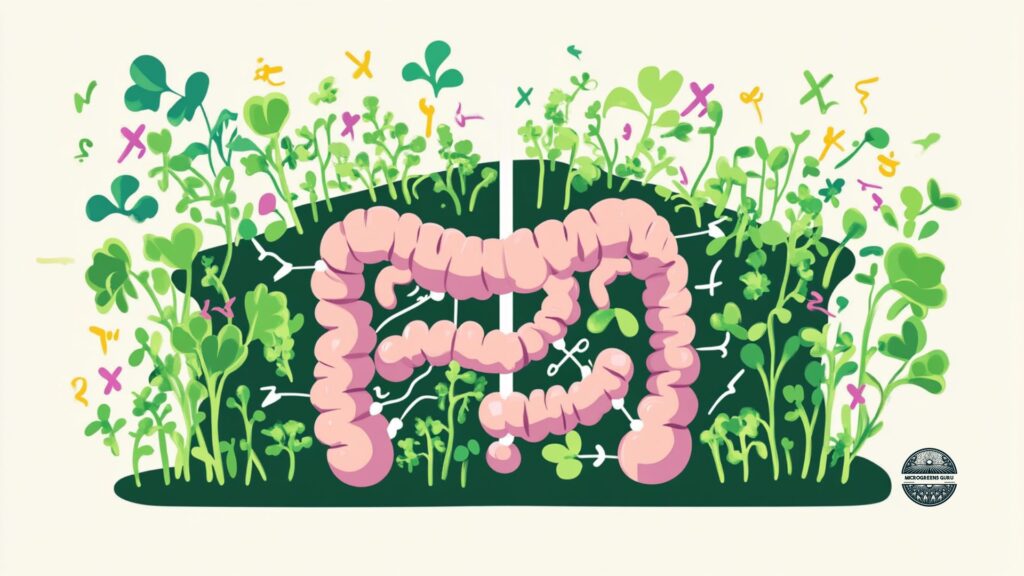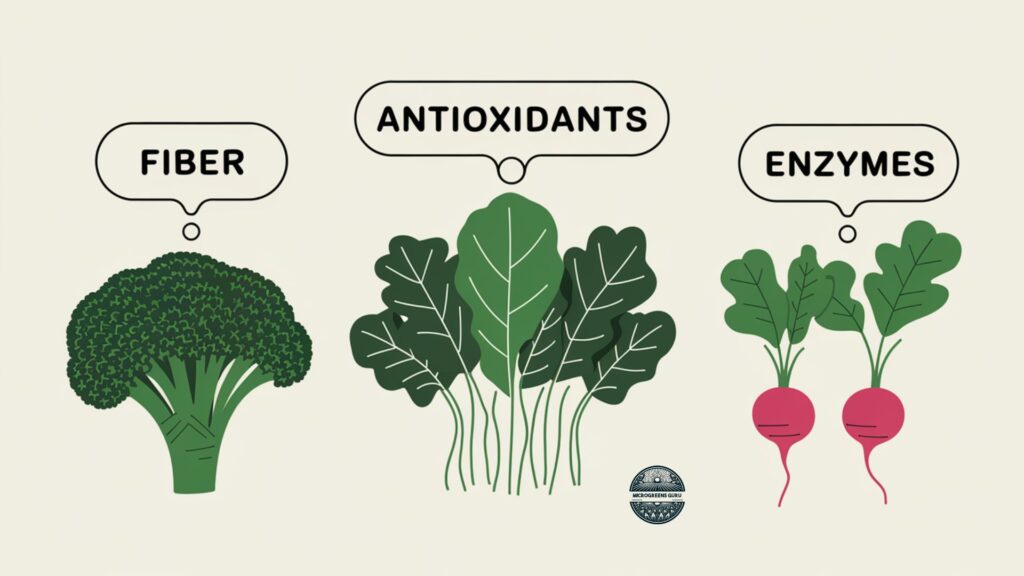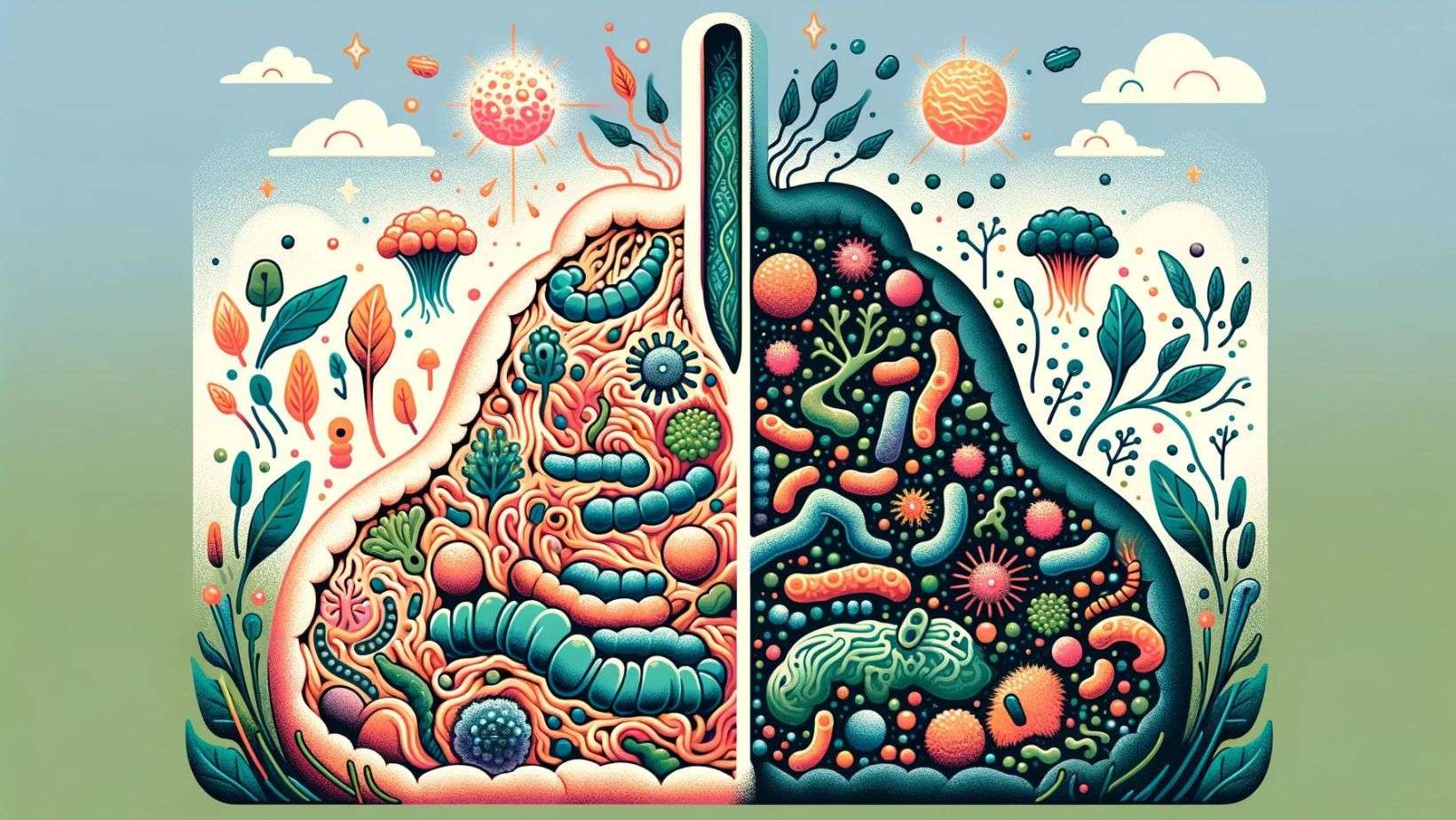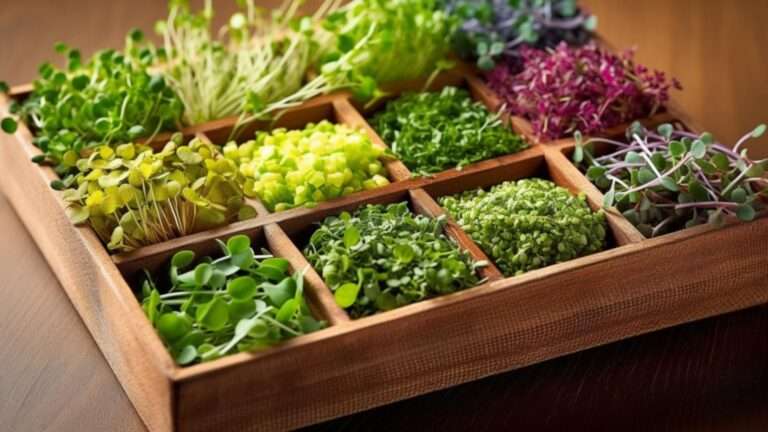Microgreens for Gut Health: How Tiny Greens Promote Gut Microbiome Diversity
Some of our posts on Microgreensguru.com contain affiliate links. If you click on an affiliate link and make a purchase, we may receive a commission. Clicking on an affiliate link that earns a commission does NOT result in additional charges or costs you extra. Earnings from affiliate links help keep this website running. See our full affiliate disclosure here.
Have you ever wondered if those tiny, vibrant greens could be the key to unlocking a healthier gut?
Microgreens, the young seedlings of edible plants, are making waves in the world of digestive wellness. These nutrient-dense powerhouses pack a punch when it comes to supporting gut health and promoting a diverse microbiome.
As more people seek natural ways to improve their digestion, microgreens have emerged as a promising addition to a balanced diet.
But what makes these miniature greens so special for our gut?
From their high fiber content to their abundance of enzymes and antioxidants, microgreens offer a unique combination of benefits that can help nourish your digestive system.
Whether you’re dealing with occasional bloating or looking to support your overall gut health, understanding the role of microgreens in your diet could be a game-changer.
Let’s explore how these tiny greens can make a big impact on your gut microbiome and overall digestive wellness.

Key Takeaways:
- Microgreens are rich in fiber, enzymes, and antioxidants that support gut health
- They contain prebiotics that feed beneficial gut bacteria
- Certain microgreens, like broccoli, are high in sulforaphane, which has anti-inflammatory properties
- Incorporating microgreens into your daily diet can improve digestion and reduce bloating
- Growing microgreens at home ensures freshness and reduces exposure to pesticides
Understanding Microgreens
Microgreens are young vegetable greens harvested within 7-21 days after germination. These tiny plants are typically 1-3 inches tall and come in a variety of flavors, colors, and textures. Despite their small size, microgreens boast a nutritional profile that often surpasses their mature counterparts.
The concentrated nutrients in microgreens make them an excellent addition to any diet, especially for those looking to support their gut health. These young plants are packed with vitamins, minerals, antioxidants, and enzymes that can contribute to overall digestive wellness.
Microgreens: Tiny Powerhouses for Gut Health
Rich in Fiber
Microgreens are packed with dietary fiber, promoting healthy digestion and supporting beneficial gut bacteria.
Nutrient Dense
Concentrated vitamins, minerals, and antioxidants in microgreens support overall gut health and function.
Anti-Inflammatory
Many microgreens contain compounds that help reduce inflammation in the digestive system.
Enzyme Boost
The high enzyme content in microgreens aids in digestion and nutrient absorption, promoting gut health.
The Gut Microbiome: An Overview
The gut microbiome refers to the trillions of microorganisms residing in our digestive tract. This complex ecosystem plays a crucial role in various aspects of our health, including digestion, immune function, and even mental well-being.
A diverse gut microbiome is generally associated with better health outcomes. Factors that influence gut microbiome diversity include diet, stress levels, antibiotic use, and environmental exposures. By incorporating microgreens into your diet, you can positively impact your gut microbiome diversity and support overall digestive health.

How Microgreens Support Gut Health
Microgreens offer several benefits for gut health, making them a valuable addition to any diet focused on digestive wellness.
Fiber Content
Microgreens are rich in dietary fiber, which is essential for maintaining gut health. Fiber acts as a prebiotic, feeding the beneficial bacteria in your gut and promoting regular bowel movements. This can help prevent constipation and support overall digestive function.
Enzymes and Nutrient Absorption
The high concentration of living enzymes in microgreens can enhance the breakdown of food substances and improve nutrient absorption. This can lead to better digestion and reduced instances of bloating or discomfort after meals.
Antioxidants and Anti-inflammatory Properties
Many microgreens are packed with antioxidants and compounds with anti-inflammatory properties. These substances can help reduce inflammation in the digestive system, potentially alleviating symptoms of inflammatory bowel conditions and supporting overall gut health.
Prebiotics and Probiotics
Some microgreens contain prebiotic fibers that feed the beneficial bacteria in your gut. While microgreens themselves don’t contain probiotics, their prebiotic content can help create an environment where probiotic bacteria can thrive, promoting a healthy balance of gut flora.
Timeline of Gut Health Benefits from Microgreens
Immediate Benefits
Improved digestion due to high fiber content, aiding bowel regularity.
1-2 Weeks
Reduced bloating and improved overall digestive comfort.
2-4 Weeks
Positive influence on gut microbiome, supporting growth of beneficial bacteria.
4-8 Weeks
Reduced gut inflammation due to anti-inflammatory properties of microgreens.
Several Months
More balanced and diverse gut microbiome, improved nutrient absorption, enhanced immune function, and better overall digestive health.
Top Microgreens for Gut Health
While all microgreens offer health benefits, some varieties are particularly beneficial for gut health:
- Broccoli Microgreens: Rich in sulforaphane, a compound known for its anti-inflammatory and antioxidant properties. Sulforaphane may help protect against gut inflammation and support the gut barrier function.
- Kale Microgreens: High in fiber and antioxidants, kale microgreens can support digestive health and help reduce inflammation in the gut.
- Radish Microgreens: Known for their spicy flavor, radish microgreens contain compounds that can stimulate digestive enzymes and promote better nutrient absorption.
- Sunflower Microgreens: These are rich in chlorophyll, which has detoxifying properties and may help cleanse the digestive tract.
- Beet Microgreens: Packed with betalains, antioxidants that can help reduce inflammation in the gut and support overall digestive health.

Incorporating Microgreens into Your Diet
Adding microgreens to your daily meals is simple and can significantly boost your nutrient intake. Here are some easy ways to incorporate them:
- Add them to salads for an extra nutrient boost and flavor punch
- Use as a garnish for soups, stews, or main dishes
- Blend into smoothies for a nutrient-dense green boost
- Use as a topping for sandwiches or wraps
- Mix into omelets or scrambled eggs for a nutritious breakfast
When preparing microgreens, it’s best to consume them raw to preserve their nutritional value. If you’re cooking with them, add them at the end of the cooking process to minimize nutrient loss.
To keep your microgreens fresh, store them in the refrigerator in a container lined with a slightly damp paper towel. Consume within a week for optimal freshness and nutritional benefits.
The Gut-Brain Connection and Microgreens
The gut-brain axis is a bidirectional communication system between the gastrointestinal tract and the central nervous system. Recent research has shown that the health of our gut can significantly impact our mood, cognitive function, and overall mental well-being.
Microgreens, with their high concentration of nutrients and bioactive compounds, may play a role in supporting this gut-brain connection. The antioxidants and anti-inflammatory compounds found in microgreens can help reduce oxidative stress and inflammation, which are linked to various neurological and mental health conditions.
Moreover, the fiber content in microgreens supports the growth of beneficial gut bacteria, which produce neurotransmitters like serotonin. This “feel-good” hormone is crucial for mood regulation and cognitive function.
By incorporating microgreens into your diet, you’re not just supporting your gut health, but potentially boosting your mental well-being as well.
Growing Microgreens at Home
One of the best ways to ensure a constant supply of fresh, nutrient-dense microgreens is to grow them at home. Home-grown microgreens offer several advantages:
- Freshness: You can harvest right before consumption, ensuring maximum nutritional value.
- Cost-effective: Growing your own is often cheaper than buying microgreens regularly.
- Pesticide-free: You have control over the growing conditions, avoiding harmful chemicals.
- Variety: You can grow a wide range of microgreens to suit your taste preferences.
Basic growing instructions:
- Choose a container with drainage holes.
- Fill with a sterile seed-starting mix.
- Sprinkle seeds evenly over the soil surface.
- Lightly cover with a thin layer of soil.
- Water gently and keep the soil moist.
- Place in a sunny spot or under grow lights.
- Harvest when the first true leaves appear, typically 7-21 days after planting.
Growing microgreens at home can be a rewarding experience that connects you more closely with your food and its impact on your gut health.
The Role of Microgreens in a Balanced Diet
While microgreens offer numerous health benefits, it’s important to remember that they should be part of a balanced diet rather than a standalone solution for gut health. Here’s how microgreens can complement other dietary components:
Complementing Probiotic Foods
Microgreens, rich in prebiotics, can work synergistically with probiotic foods like yogurt, kefir, and fermented vegetables. The prebiotics in microgreens provide nourishment for the beneficial bacteria introduced by probiotic foods, potentially enhancing their effectiveness.
Enhancing Nutrient Absorption
The high enzyme content in microgreens can aid in the digestion and absorption of nutrients from other foods. For example, adding microgreens to a meal containing iron-rich foods might improve iron absorption due to the vitamin C content in many microgreen varieties.
Balancing Macronutrients
While microgreens are low in calories, they’re packed with micronutrients. This makes them an excellent addition to meals rich in proteins and healthy fats, helping to create a more nutritionally balanced plate.
Supporting Detoxification
The chlorophyll content in microgreens, particularly in varieties like wheatgrass and sunflower, can support the body’s natural detoxification processes. This can complement other detoxifying foods in your diet, such as cruciferous vegetables and herbs.
Microgreens and Specific Health Conditions
Emerging research suggests that microgreens may have potential benefits for various health conditions related to gut health:
Inflammatory Bowel Disease (IBD)
The anti-inflammatory properties of certain microgreens, particularly those from the Brassica family like broccoli and kale, may help alleviate symptoms of IBD. The sulforaphane in broccoli microgreens, for instance, has shown promise in reducing inflammation in the gut.
Type 2 Diabetes
Some studies suggest that microgreens may help improve insulin sensitivity and glucose metabolism. The high antioxidant content and potential anti-inflammatory effects of microgreens could contribute to better blood sugar control.
Cardiovascular Health
The nutrient density of microgreens, particularly their high content of heart-healthy compounds like polyphenols and omega-3 fatty acids, may support cardiovascular health. This is particularly relevant given the growing understanding of the gut-heart axis.
Obesity
The fiber content in microgreens can promote feelings of fullness and support healthy weight management. Additionally, some research suggests that compounds in certain microgreens may influence fat metabolism.
While more research is needed to fully understand the impact of microgreens on these conditions, incorporating them into a balanced diet as part of a healthy lifestyle may offer potential benefits.
Product Recommendations
Incorporating microgreens into your diet for gut health can be made easier with the right tools and resources. Here are some products that can help you on your microgreen journey:
- Organic Microgreens Growing Kit: This all-in-one kit includes seeds, soil, and trays to get you started with growing your own microgreens at home.
- High-Quality LED Grow Light: Ideal for indoor growing, especially during winter months or in low-light areas.
- Microgreens Seed Variety Pack: Offers a selection of seeds known for their gut health benefits, including broccoli, kale, and radish.
- Glass Sprouting Jars: Perfect for growing smaller batches of microgreens or sprouts.
- Digital pH Soil Tester: Helps maintain optimal soil conditions for healthy microgreen growth.
- Organic Liquid Fertilizer: Ensures your microgreens receive all necessary nutrients for optimal growth and nutritional content.
- Microgreens Scissors: Designed for easy and clean harvesting of your homegrown microgreens.
These products can enhance your microgreen growing experience, making it easier to incorporate these nutrient-dense greens into your diet for improved gut health. From seeds to harvesting tools, having the right equipment can make a significant difference in your microgreen journey.
The inclusion of microgreens in your diet can be a practical and effective way to support gut health. By choosing the right varieties and using proper growing and preparation techniques, you can maximize the benefits of these tiny powerhouses for your digestive system.
Further Reading
To deepen your understanding of microgreens and their impact on gut health, consider exploring these related articles:
- Best Soil to Use for Microgreens: Achieving Lush, Nutrient-Rich Harvests – This article provides insights into the ideal growing medium for microgreens, which can affect their nutritional content and gut health benefits.
- Can You Eat Too Many Microgreens? Expert Insight into Quantity and Health Impacts – Learn about the optimal consumption of microgreens for gut health and overall well-being.
- Types of Microgreens: The Definitive Guide to Growing, Harvesting, and Enjoying – Explore various microgreen varieties and their specific health benefits, including those particularly beneficial for gut health.
- Are Microgreens Good for You? The Definitive Answer Backed by Science – Dive deeper into the scientific evidence supporting the health benefits of microgreens, including their impact on gut health.
- How Fast Do Microgreens Grow? – Understand the growth cycle of microgreens and how it relates to their nutrient density and gut health benefits.
These articles offer valuable information on growing, consuming, and understanding microgreens, helping you make the most of these tiny powerhouses for your gut health. By expanding your knowledge, you can optimize your use of microgreens to support a healthy, diverse gut microbiome.
Frequently Asked Questions About Microgreens for Gut Health
Are microgreens good for your gut?
Yes, microgreens can be beneficial for gut health. They are rich in dietary fiber, which supports healthy digestion and feeds beneficial gut bacteria. Microgreens also contain enzymes that can aid in nutrient absorption and compounds that may reduce inflammation in the digestive system. Their high nutrient density and variety of bioactive compounds make them a valuable addition to a gut-healthy diet.
What microgreens are anti-inflammatory?
Many microgreens have anti-inflammatory properties, but some stand out:
- Broccoli microgreens: High in sulforaphane, a potent anti-inflammatory compound.
- Red cabbage microgreens: Rich in anthocyanins, which have strong anti-inflammatory effects.
- Kale microgreens: Contain various antioxidants that combat inflammation.
- Radish microgreens: Offer isothiocyanates, known for their anti-inflammatory properties.
- Beet microgreens: High in betalain and have been shown to reduce inflammation.
These microgreens can be particularly beneficial for gut health due to their anti-inflammatory properties.
Is it good to eat microgreens every day?
Eating microgreens daily can be a healthy practice as part of a balanced diet. Microgreens offer a concentrated source of nutrients and can help meet your daily vegetable intake requirements. Their variety in flavors and nutrients makes them easy to incorporate into different meals. However, as with any food, moderation is key. Aim for a diverse diet that includes a range of vegetables, including microgreens, to ensure you’re getting a wide spectrum of nutrients.
What is the number one vegetable for inflammation?
While many vegetables have anti-inflammatory properties, broccoli and its microgreens are often cited as top contenders for reducing inflammation. Broccoli, especially in its microgreen form, is rich in sulforaphane, a compound with potent anti-inflammatory and antioxidant properties. Studies have shown that sulforaphane can activate anti-inflammatory pathways in the body and may help in preventing and managing various inflammatory conditions, including those affecting the gut.
However, it’s important to note that a diet rich in a variety of colorful vegetables, including microgreens, can provide a range of anti-inflammatory compounds that work synergistically to support overall health and reduce inflammation.
Microgreens and Gut Health Quiz
Final Thoughts
Microgreens offer a powerful and accessible way to support gut health and promote a diverse gut microbiome. Their high nutrient density, fiber content, and bioactive compounds make them an excellent addition to any diet focused on digestive wellness. By incorporating a variety of microgreens into your meals, you can potentially improve digestion, reduce inflammation, and support the growth of beneficial gut bacteria.
Remember, while microgreens can be a valuable tool in promoting gut health, they should be part of a balanced diet and healthy lifestyle. For personalized advice on using microgreens for gut health, consider consulting with a healthcare professional or registered dietitian.
As you continue your journey towards better gut health, consider exploring the wealth of information available on Microgreens Guru.
Our site offers comprehensive guides, tips, and insights on growing, consuming, and benefiting from microgreens.
Your Thoughts Matter
Have you tried incorporating microgreens into your diet for gut health?
We’d love to hear about your experiences, questions, or insights.
Share your thoughts in the comments below or reach out to us directly.
Your feedback helps us continue to provide valuable information and support to our community of microgreen enthusiasts.

Cal Hewitt is the Founder and Lead Cultivator at Microgreens Guru, a website dedicated to empowering individuals to grow, consume, and potentially sell nutrient-dense microgreens. With 5 years of hands-on experience in microgreens cultivation, Cal brings a unique analytical perspective to the world of urban agriculture. He specializes in optimizing growth techniques for various microgreen varieties, while also focusing on sustainable and cost-effective growing methods. Cal’s passion for microgreens, ignited by a personal health journey, drives him to continuously explore and share innovative approaches to microgreens cultivation. His practical experience, combined with his commitment to education through his website and upcoming book, ensures that Microgreens Guru remains a valuable resource for both novice and experienced growers alike.








